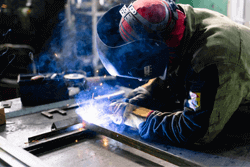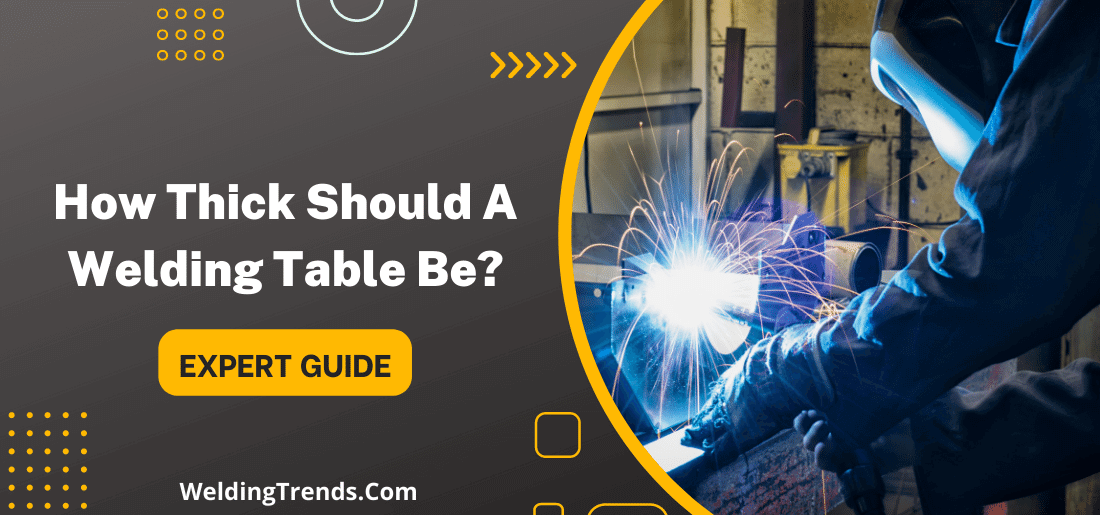When deciding on the thickness of a welding table, there are many factors to consider. The most important thing is to make sure the table can withstand the heat and force of the welding process.
A table that is too thin may not be able to support the weight of the materials being welded while a thicker table will be more durable, but it will also be heavier and more costly. There is no one perfect answer to this question; it depends on your specific needs.
In this blog post, we explore the thicknesses for welding tables, so you can make an informed decision.
How Thick Should a Welding Table Be?
When it comes to welding, having a sturdy and reliable table is critical. The table needs to be able to withstand the high temperatures and pressures of the welding process without warping or breaking.
welding table top thickness
There are a few factors to consider when deciding on the thickness of your welding table:
The most important factor is the type of welding you’ll be doing.
- If you’re planning on doing heavy-duty welding, then you’ll need a thicker table that can support the weight of the materials being welded. A good rule of thumb is to choose a table that is at least 1/4 inch thick.
- However, if you’re only going to be doing light welding, a thinner table will suffice. A thicker table will be more expensive than a thinner one, but it will also be more durable. A table that is 1/8 inch thick will be sufficient for most light welding jobs.
- Finally, you need to think about the weight of the table. A thicker table will be heavier than a thinner one, so you need to make sure you have enough space to store it.
importance of sturdy & durable welding table top And its Benefits
A welding table is a key piece of equipment for any welder. It needs to be able to withstand the high temperatures welding process
Benefits of Thicker Welding Top
- Durable welding table withstands the high pressure of the welding process.
- It will last for many years and can be used for a variety of different projects.
- Durable welding table is an investment that will pay for itself over time.
- It will make your welding projects easier and more enjoyable.
- Durable welding table will increase the quality of your welds.
What material should you use to make a welding table Top?

There are a few different materials you can use to make your welding table. The most important thing to consider is the thickness of the material. You need to make sure the material is thick enough to support the weight of the items being welded.
Some common materials used for welding tables include:
Steel: Steel is a durable material that can withstand high temperatures and pressures. It is also relatively inexpensive. However, steel is very heavy, so it may not be suitable for all projects.
Aluminum: Aluminum is lighter than steel, but it is still very strong and durable. Aluminum is more expensive than steel, but it will not rust or corrode over time.
Wood: Wood is an option for those who want a lighter table. However, it is not as durable as steel or aluminum and it can catch fire if it gets too hot. Wood can warp or break under the high temperatures and pressures of welding.
MDF: MDF is a type of wood that is made from sawdust and other wood fibers. It is very strong and durable, but it is also very heavy.
Plywood: Plywood is a type of wood that is made from layers of thin wood veneer. It is lightweight and inexpensive, but it is not as strong as MDF or steel.
FAQs – Welding Table Thickness
Is 1/4 thick enough for a welding table?
There is no definitive answer to this question as it depends on various factors such as the type of welding you will be doing, the weight of the materials you will be welding, and your personal preference.
However, 1/4 inch thick material is generally considered to be a good thickness for a welding table. If you are planning on doing a lot of heavy duty welding, you may want to consider a thicker material such as 1/2 inch or 3/4 inch.
What is good size for a welding table?
There is no definitive answer to this question. It depends on the size of the projects you’ll be working on and the amount of space you have available. A good rule of thumb is to choose a table that is at least 3 feet by 5 feet. This will give you enough space to work on most projects without being too cramped.
What is minimum thickness for welding?
The minimum thickness for welding is generally considered to be 1/4 inch. However, if you’re only doing light welding, a thinner table will suffice. It’s also important to consider the cost of the table. Choose a table that is the right thickness for your needs.
What kind of steel is used for welding tables?
The most common type of steel used for welding tables is carbon steel. Carbon steel is strong and durable, but it can rust over time if it’s not properly cared for.
If you want a table that will last for many years, then choose one made from stainless steel. Stainless steel is more expensive than carbon steel, but it doesn’t rust or corrode.
Should a welding table be grounded?
Yes, a welding table should be grounded. This will help to prevent electrical shocks and will also help to improve the quality of your welds. Make sure the table is properly grounded before beginning any welding projects.
Why do welding tables have holes?
Welding tables have holes for a few different reasons.
- First reason is to allow sparks and hot metal to fall through the table instead of onto the floor. This helps to keep your workspace clean and safe.
- Second reason is to help ventilate the area. The holes allow air to circulate so that the fumes from welding don’t build up and become overwhelming.
- Third reason is to allow you to clamp materials to the table. By running a clamp through a hole in the table, you can secure materials in place while you work on them.
Wrap Up
Welding tables come in different thicknesses and it is important to select the right one for your needs. The table should be thick enough so that it does not warp or bend, but also thin enough so that it is easy to move around.
A good rule of thumb is to select a table that is at least 1/4 inch thick.
The size and shape of the welding table are also important factors to consider when choosing a thickness. A smaller, narrower table can get away with being thinner than a larger, more rectangular one.
When in doubt, it’s always best to go with a thicker table to ensure safety and stability during your welding project.
If you are unsure which thickness is best for you, contact a welding supplier for assistance.




